Yuan Lin
Harnessing Uncertainty: Entropy-Modulated Policy Gradients for Long-Horizon LLM Agents
Sep 11, 2025Abstract:In long-horizon tasks, recent agents based on Large Language Models (LLMs) face a significant challenge that sparse, outcome-based rewards make it difficult to assign credit to intermediate steps. Previous methods mainly focus on creating dense reward signals to guide learning, either through traditional reinforcement learning techniques like inverse reinforcement learning or by using Process Reward Models for step-by-step feedback. In this paper, we identify a fundamental problem in the learning dynamics of LLMs: the magnitude of policy gradients is inherently coupled with the entropy, which leads to inefficient small updates for confident correct actions and potentially destabilizes large updates for uncertain ones. To resolve this, we propose Entropy-Modulated Policy Gradients (EMPG), a framework that re-calibrates the learning signal based on step-wise uncertainty and the final task outcome. EMPG amplifies updates for confident correct actions, penalizes confident errors, and attenuates updates from uncertain steps to stabilize exploration. We further introduce a bonus term for future clarity that encourages agents to find more predictable solution paths. Through comprehensive experiments on three challenging agent tasks, WebShop, ALFWorld, and Deep Search, we demonstrate that EMPG achieves substantial performance gains and significantly outperforms strong policy gradient baselines. Project page is at https://empgseed-seed.github.io/
IPBench: Benchmarking the Knowledge of Large Language Models in Intellectual Property
Apr 22, 2025Abstract:Intellectual Property (IP) is a unique domain that integrates technical and legal knowledge, making it inherently complex and knowledge-intensive. As large language models (LLMs) continue to advance, they show great potential for processing IP tasks, enabling more efficient analysis, understanding, and generation of IP-related content. However, existing datasets and benchmarks either focus narrowly on patents or cover limited aspects of the IP field, lacking alignment with real-world scenarios. To bridge this gap, we introduce the first comprehensive IP task taxonomy and a large, diverse bilingual benchmark, IPBench, covering 8 IP mechanisms and 20 tasks. This benchmark is designed to evaluate LLMs in real-world intellectual property applications, encompassing both understanding and generation. We benchmark 16 LLMs, ranging from general-purpose to domain-specific models, and find that even the best-performing model achieves only 75.8% accuracy, revealing substantial room for improvement. Notably, open-source IP and law-oriented models lag behind closed-source general-purpose models. We publicly release all data and code of IPBench and will continue to update it with additional IP-related tasks to better reflect real-world challenges in the intellectual property domain.
PaSa: An LLM Agent for Comprehensive Academic Paper Search
Jan 17, 2025



Abstract:We introduce PaSa, an advanced Paper Search agent powered by large language models. PaSa can autonomously make a series of decisions, including invoking search tools, reading papers, and selecting relevant references, to ultimately obtain comprehensive and accurate results for complex scholarly queries. We optimize PaSa using reinforcement learning with a synthetic dataset, AutoScholarQuery, which includes 35k fine-grained academic queries and corresponding papers sourced from top-tier AI conference publications. Additionally, we develop RealScholarQuery, a benchmark collecting real-world academic queries to assess PaSa performance in more realistic scenarios. Despite being trained on synthetic data, PaSa significantly outperforms existing baselines on RealScholarQuery, including Google, Google Scholar, Google with GPT-4 for paraphrased queries, chatGPT (search-enabled GPT-4o), GPT-o1, and PaSa-GPT-4o (PaSa implemented by prompting GPT-4o). Notably, PaSa-7B surpasses the best Google-based baseline, Google with GPT-4o, by 37.78% in recall@20 and 39.90% in recall@50. It also exceeds PaSa-GPT-4o by 30.36% in recall and 4.25% in precision. Model, datasets, and code are available at https://github.com/bytedance/pasa.
Tarsier2: Advancing Large Vision-Language Models from Detailed Video Description to Comprehensive Video Understanding
Jan 14, 2025Abstract:We introduce Tarsier2, a state-of-the-art large vision-language model (LVLM) designed for generating detailed and accurate video descriptions, while also exhibiting superior general video understanding capabilities. Tarsier2 achieves significant advancements through three key upgrades: (1) Scaling pre-training data from 11M to 40M video-text pairs, enriching both volume and diversity; (2) Performing fine-grained temporal alignment during supervised fine-tuning; (3) Using model-based sampling to automatically construct preference data and applying DPO training for optimization. Extensive experiments show that Tarsier2-7B consistently outperforms leading proprietary models, including GPT-4o and Gemini 1.5 Pro, in detailed video description tasks. On the DREAM-1K benchmark, Tarsier2-7B improves F1 by 2.8\% over GPT-4o and 5.8\% over Gemini-1.5-Pro. In human side-by-side evaluations, Tarsier2-7B shows a +8.6\% performance advantage over GPT-4o and +24.9\% over Gemini-1.5-Pro. Tarsier2-7B also sets new state-of-the-art results across 15 public benchmarks, spanning tasks such as video question-answering, video grounding, hallucination test, and embodied question-answering, demonstrating its versatility as a robust generalist vision-language model.
AutoPatent: A Multi-Agent Framework for Automatic Patent Generation
Dec 13, 2024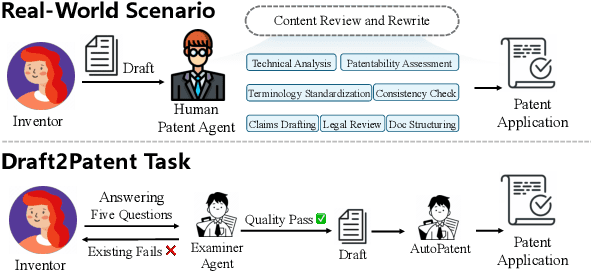
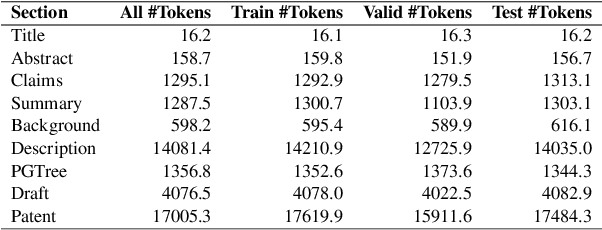
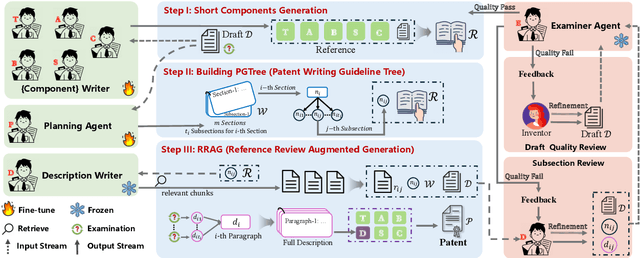
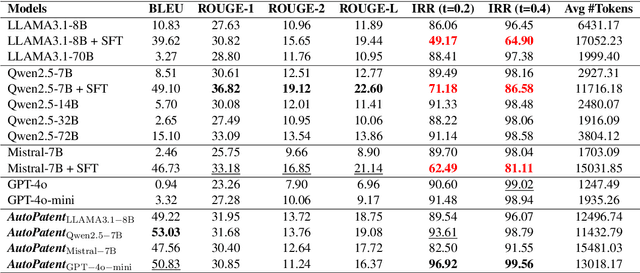
Abstract:As the capabilities of Large Language Models (LLMs) continue to advance, the field of patent processing has garnered increased attention within the natural language processing community. However, the majority of research has been concentrated on classification tasks, such as patent categorization and examination, or on short text generation tasks like patent summarization and patent quizzes. In this paper, we introduce a novel and practical task known as Draft2Patent, along with its corresponding D2P benchmark, which challenges LLMs to generate full-length patents averaging 17K tokens based on initial drafts. Patents present a significant challenge to LLMs due to their specialized nature, standardized terminology, and extensive length. We propose a multi-agent framework called AutoPatent which leverages the LLM-based planner agent, writer agents, and examiner agent with PGTree and RRAG to generate lengthy, intricate, and high-quality complete patent documents. The experimental results demonstrate that our AutoPatent framework significantly enhances the ability to generate comprehensive patents across various LLMs. Furthermore, we have discovered that patents generated solely with the AutoPatent framework based on the Qwen2.5-7B model outperform those produced by larger and more powerful LLMs, such as GPT-4o, Qwen2.5-72B, and LLAMA3.1-70B, in both objective metrics and human evaluations. We will make the data and code available upon acceptance at \url{https://github.com/QiYao-Wang/AutoPatent}.
StoryTeller: Improving Long Video Description through Global Audio-Visual Character Identification
Nov 11, 2024
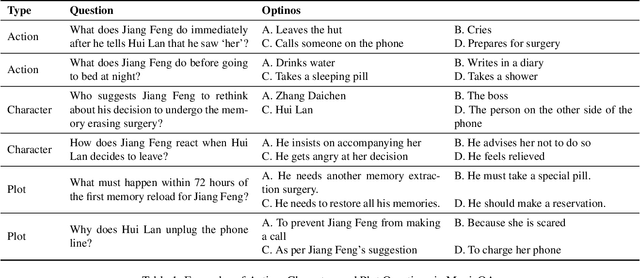

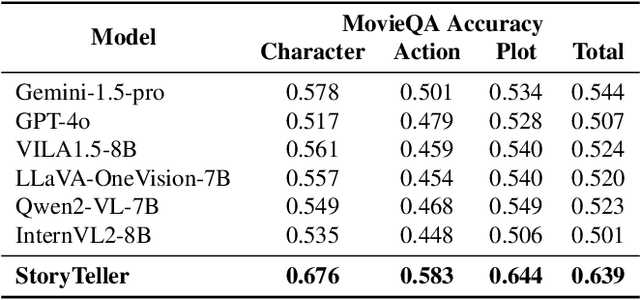
Abstract:Existing large vision-language models (LVLMs) are largely limited to processing short, seconds-long videos and struggle with generating coherent descriptions for extended video spanning minutes or more. Long video description introduces new challenges, such as plot-level consistency across descriptions. To address these, we figure out audio-visual character identification, matching character names to each dialogue, as a key factor. We propose StoryTeller, a system for generating dense descriptions of long videos, incorporating both low-level visual concepts and high-level plot information. StoryTeller uses a multimodal large language model that integrates visual, audio, and text modalities to perform audio-visual character identification on minute-long video clips. The results are then fed into a LVLM to enhance consistency of video description. We validate our approach on movie description tasks and introduce MovieStory101, a dataset with dense descriptions for three-minute movie clips. To evaluate long video descriptions, we create MovieQA, a large set of multiple-choice questions for the MovieStory101 test set. We assess descriptions by inputting them into GPT-4 to answer these questions, using accuracy as an automatic evaluation metric. Experiments show that StoryTeller outperforms all open and closed-source baselines on MovieQA, achieving 9.5% higher accuracy than the strongest baseline, Gemini-1.5-pro, and demonstrating a +15.56% advantage in human side-by-side evaluations. Additionally, incorporating audio-visual character identification from StoryTeller improves the performance of all video description models, with Gemini-1.5-pro and GPT-4o showing relative improvement of 5.5% and 13.0%, respectively, in accuracy on MovieQA.
IPEval: A Bilingual Intellectual Property Agency Consultation Evaluation Benchmark for Large Language Models
Jun 18, 2024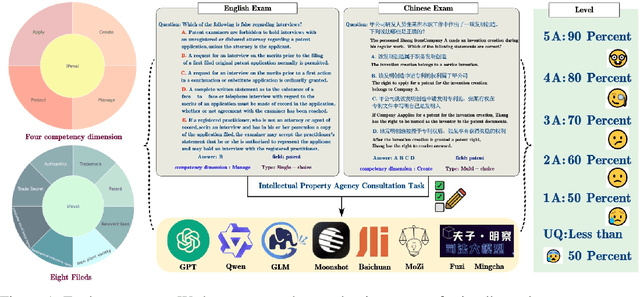
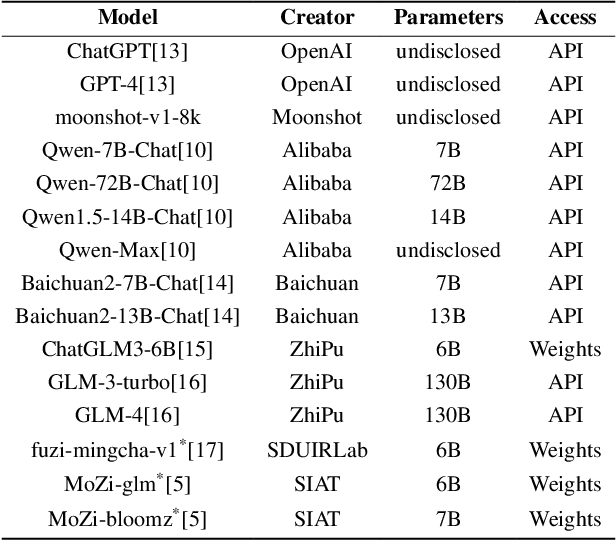
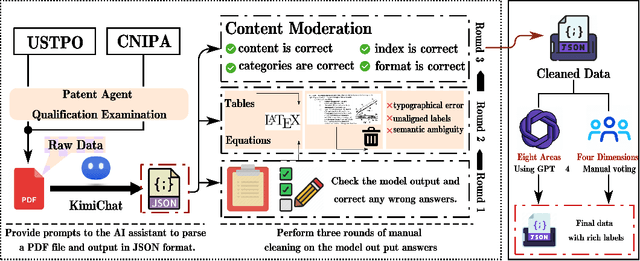
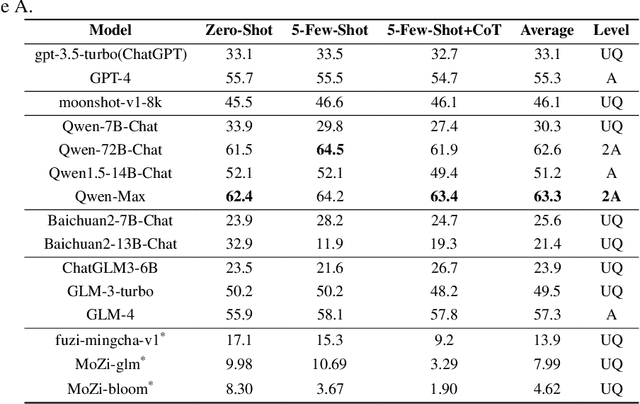
Abstract:The rapid development of Large Language Models (LLMs) in vertical domains, including intellectual property (IP), lacks a specific evaluation benchmark for assessing their understanding, application, and reasoning abilities. To fill this gap, we introduce IPEval, the first evaluation benchmark tailored for IP agency and consulting tasks. IPEval comprises 2657 multiple-choice questions across four major dimensions: creation, application, protection, and management of IP. These questions span patent rights (inventions, utility models, designs), trademarks, copyrights, trade secrets, and other related laws. Evaluation methods include zero-shot, 5-few-shot, and Chain of Thought (CoT) for seven LLM types, predominantly in English or Chinese. Results show superior English performance by models like GPT series and Qwen series, while Chinese-centric LLMs excel in Chinese tests, albeit specialized IP LLMs lag behind general-purpose ones. Regional and temporal aspects of IP underscore the need for LLMs to grasp legal nuances and evolving laws. IPEval aims to accurately gauge LLM capabilities in IP and spur development of specialized models. Website: \url{https://ipeval.github.io/}
AGILE: A Novel Framework of LLM Agents
May 23, 2024



Abstract:We introduce a novel framework of LLM agents named AGILE (AGent that Interacts and Learns from Environments) designed to perform complex conversational tasks with users, leveraging LLMs, memory, tools, and interactions with experts. The agent's abilities include not only conversation but also reflection, utilization of tools, and consultation with experts. We formulate the construction of such an LLM agent as a reinforcement learning problem, in which the LLM serves as the policy model. We fine-tune the LLM using labeled data of actions and the PPO algorithm. We focus on question answering and release a dataset for agents called ProductQA, comprising challenging questions in online shopping. Our extensive experiments on ProductQA and MedMCQA show that AGILE agents based on 13B and 7B LLMs trained with PPO can outperform GPT-4 agents. Our ablation study highlights the indispensability of memory, tools, consultation, reflection, and reinforcement learning in achieving the agent's strong performance.
Autonomous vehicle decision and control through reinforcement learning with traffic flow randomization
Mar 05, 2024



Abstract:Most of the current studies on autonomous vehicle decision-making and control tasks based on reinforcement learning are conducted in simulated environments. The training and testing of these studies are carried out under rule-based microscopic traffic flow, with little consideration of migrating them to real or near-real environments to test their performance. It may lead to a degradation in performance when the trained model is tested in more realistic traffic scenes. In this study, we propose a method to randomize the driving style and behavior of surrounding vehicles by randomizing certain parameters of the car-following model and the lane-changing model of rule-based microscopic traffic flow in SUMO. We trained policies with deep reinforcement learning algorithms under the domain randomized rule-based microscopic traffic flow in freeway and merging scenes, and then tested them separately in rule-based microscopic traffic flow and high-fidelity microscopic traffic flow. Results indicate that the policy trained under domain randomization traffic flow has significantly better success rate and calculative reward compared to the models trained under other microscopic traffic flows.
Safe Hybrid-Action Reinforcement Learning-Based Decision and Control for Discretionary Lane Change
Mar 01, 2024Abstract:Autonomous lane-change, a key feature of advanced driver-assistance systems, can enhance traffic efficiency and reduce the incidence of accidents. However, safe driving of autonomous vehicles remains challenging in complex environments. How to perform safe and appropriate lane change is a popular topic of research in the field of autonomous driving. Currently, few papers consider the safety of reinforcement learning in autonomous lane-change scenarios. We introduce safe hybrid-action reinforcement learning into discretionary lane change for the first time and propose Parameterized Soft Actor-Critic with PID Lagrangian (PASAC-PIDLag) algorithm. Furthermore, we conduct a comparative analysis of the Parameterized Soft Actor-Critic (PASAC), which is an unsafe version of PASAC-PIDLag. Both algorithms are employed to train the lane-change strategy of autonomous vehicles to output discrete lane-change decision and longitudinal vehicle acceleration. Our simulation results indicate that at a traffic density of 15 vehicles per kilometer (15 veh/km), the PASAC-PIDLag algorithm exhibits superior safety with a collision rate of 0%, outperforming the PASAC algorithm, which has a collision rate of 1%. The outcomes of the generalization assessments reveal that at low traffic density levels, both the PASAC-PIDLag and PASAC algorithms are proficient in attaining a 0% collision rate. Under conditions of high traffic flow density, the PASAC-PIDLag algorithm surpasses PASAC in terms of both safety and optimality.
 Add to Chrome
Add to Chrome Add to Firefox
Add to Firefox Add to Edge
Add to Edge